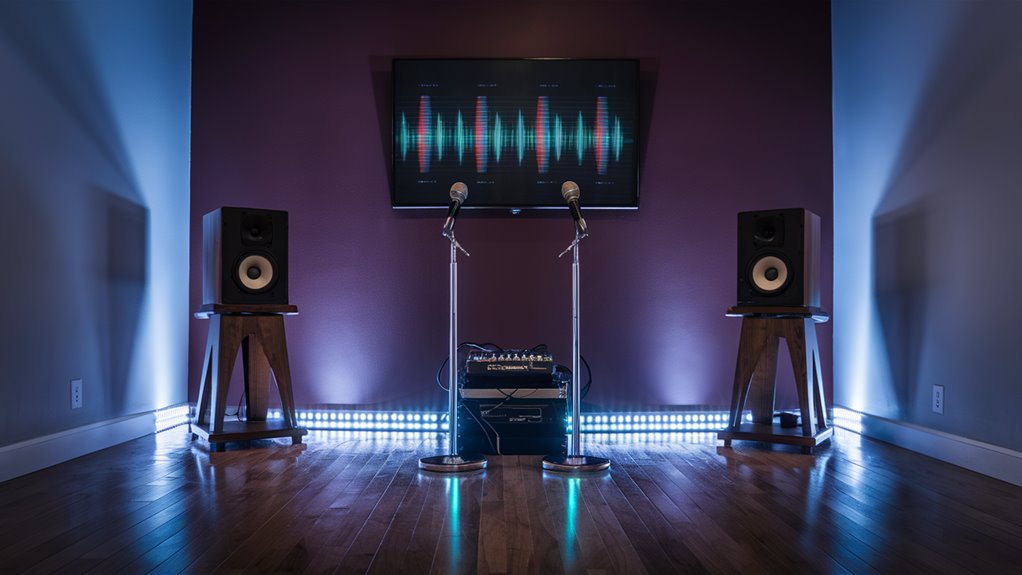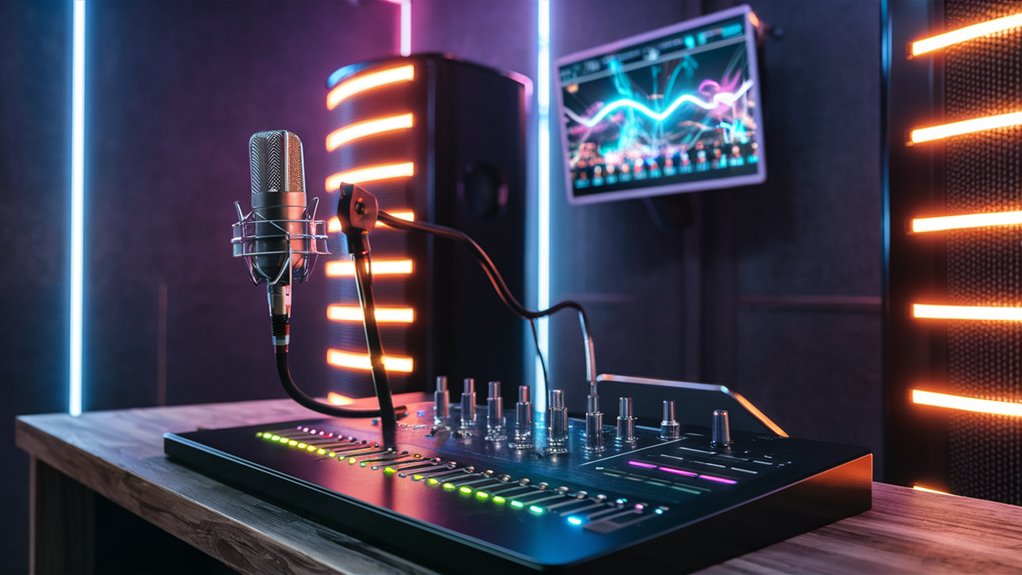Essential Elements of Modern Karaoke Systems: An In-Depth Guide
Basic Equipment Needs
For quality performance and features, a professional class system still necessitates the use of several important pieces of karaoke equipment. A high-end player’s heart can suppress vocals; and at 48kHz/24-bit resolution with at least 90dB Signal-to-Noise Ratio (SNR) it is critical to strive for performance of this magnitude. In this way, the sound delivered maintains all its richness and purity.
Audio Equipment of a Pro Grade
The microphone system is at the core of it all, and needs dual UHF dynamic microphones operating within the 470-698 MHz range precisely. To maximize voice touchiness and minimize feedback, these should be equipped with cardioid pickup patterns. A robust amplification system with at least 50+ watts per channel ensures good sound projection and clarity.
File Format Compatibility and Acoustic Treatment
Modern systems need to support multiple file formats and other forms of music library standards. Some examples include MP3+G and CDG. For acoustic optimization you can do things such as:
Sound absorbing boards
Bass traps in strategic places
Adequate treatment of the room
Balanced speaker placement
When combined correctly, these things give you an overall satisfactory quality in sound reproduction, where the effect is totally immersive for the Karaoke user. The system becomes a suitable acoustic space for any performer or audience member to enter and enjoy pleasing sounds at a high intensity level.
Standard Components of Karaoke System
Required Components of a Karaoke System
Core Component of System
A professional karaoke system requires four basic parts working in harmony to ensure optimal operation.
The audio source component provides the main framework and is often a professional karaoke player capable of processing media optical discs or other formats, as well as being able to output music tracks containing suppressed or deleted vocal tracks.
Audio Processing and Amplifying
A high-quality amplifier for processing audio signals is required with the karaoke system. This component is crucial to ensure consistent sound levels and clarity throughout every production.
The sound system must at the same time do music playback and microphone input, and ensure the perfect balance, to avoid distortion problems that might otherwise occur.
Proper Microphone Setup
Microphone systems are a crucial element in any karaoke performance.
In setting up a sound system for business use, one must arrange for a pair of high-quality professional dynamic microphones fitted with cardioids to prevent feedback. The output from these will be fed into a professional mixing console, meaning you have individual control over music-to-voice ratios and clean blending of audio.
Display Configuration
To get the best performance from this system, you need a dual-screen setup:
A monitor for the performers, serving in lyrics and timing information
An audience display that shows the synchronized content
Video outputs that work with a wide variety of formats. (HDMI, VGA, composite video)
Screens with high resolution to ensure legible text
The display must at once keep pace and be in parallel with the audio system while showing clear, readable text and looking professional and clean.
Sound Quality and Audio Processing
Audio Signal Optimization
For karaoke to reproduce that professional sound, it all begins with how clean the audio signal is. To this end, at least 90dB signal-to-noise (SNR) ratio is required so vocals come across crystal clear.
It is now essential technology for advanced audio processors to not just harmoniously blend background tracks and live vocal input, but offer much-needed features like echo cancellation and automatic gain control which eliminate annoying feedback during operations.
Digital Signal Processing Enhancement
Digital signal processing (DSP) technology turns a basic audio signal into professional-quality sound. Excellent karaoke systems possess built-in equalizers with 10 or more frequency bands. This makes possible real fine-tuning throughout the entire audio spectrum (20Hz to 20 kHz). Essential vocal enhancement features include:
Pitch correction to improve singing accuracy
Control of reverberation character–how long it decays digitally, anywhere from 0.1 to 3 seconds
Vocal elimination circuits for creating karaoke tracks
Audio Resolution and Treatment Chain
It is immeasurable to keep audio running at 48kHz 24 bits per signal through the whole chain, it will keep your sound as good as possible. With a sound resolution at this professional grade, you’ve got plenty of dynamic range to spare. It feels like you’re working in a studio all the time–from the moment you land on an airplane getting off the intercom in your hotel lobby through late-night clubs and auditioning other shows till you glimpse your own lifestyle The Ultimate Guide to Karaoke Room Prices and Hidden Fees experience at home.
Advanced Sound Management
In order to maintain the quality of sound in a professional karaoke setup, complex audio management systems are required. Real-time monitoring and adaptive noise reduction are combined to ensure that regardless of the acoustics of the venue or performing conditions, the sound produced will always be consistent and high in quality.
Microphone Selection and Technology
Professional Microphone Selection Guide for Karaoke Systems
The Technique of Dynamic Microphones
Cardioid pattern microphones make the best choice for professional karaoke setups because they are not disturbed by loud life sound (e.g. loudspeakers) and are able to make a clean voice come out.
Wireless Technology Description
UHF band environment, operating between 470 to 698 MHz, offers the best wireless application.
Digital wireless technology will provide better signal stability and audio fidelity than an equivalent analog system.
Frequency each section is agile, which means that channel scans and selects signal-free areas automatically–without interference.
Technical Requirements and Functions
The frequency response of a professional karaoke microphone must have a range from 50Hz to 15,000Hz in order to capture the full spectrum nuance of the voice.
Internal pop filters and shock mount systems combine to minimize handling noise as well as vocal plosives.
In a multi-microphone setup, switchable frequency systems prevent signal interference and preserve audio clarity in group performance.

Key Features to Look For:
Cardioid pickup pattern for concentrated vocal pick-up
UHF wireless transmission for reliability in connection
Digital signal processing for a better sound
Frequency agility of the digital type means that operation without interference is possible in advance and continually maintained
Durable construction on a long-term basis
Song Libraries and File Formats
Professional Karaoke Song Libraries and File Formats Guide
Essential Karaoke File Formats
The essential format for songs in a professional karaoke system is the pure standard format.
The primary output formats are those of the popular MP3+G and CDG (CD+Graphics) varieties. The file type used varies, but most have emerged as dominant digital standards. These special files combine music tracks with synchronized lyrics for perfect performance display.
Library Management and Format Performance
Top-quality karaoke needs comprehensive format support such as:
ZIP files for MP3+G content packages
Video formats (MP4, AVI)
Specialized karaoke databases without a lot of indexing
Multi-format compatibility for better flexibility
Audio and Visual Quality Standards
Pro-grade karaoke content has fixed quality criteria in:
Audio encoding: MP3 tracks with a minimum of 128kbps
CDG resolution: Optimal graphics are at the standard 300×216.
Storage needs: 4-5 GB for every 1000 songs
Streamed libraries: Modern systems are based on paid access 베트남밤문화
Advanced Library Functions
Today’s karaoke libraries:
Genre diversity
Regular updates to content
Artist listing
Title indexing and categorization
Cloud-based solutions
Connectivity and Output
The Essential Karaoke System Connectivity and Output Guide
Core Connection Interfaces
HDMI is the major way modern karaoke is displayed, giving both text and video an elegant and clear look.
Legacy RCA connections are also essential for any earlier television sets or projectors you might be working with.
Digital coaxial and optical ports must also be included for the best routing of audio and to ensure everyone will be able to plug into various types of sound equipment.
Professional Microphone Input
Karaoke performance professionals mainly use XLR and 1/4″ microphone inputs.
Systems with separate volume controls and independent effects for adjusting one’s mix allow this greater precision.
Bluetooth microphone: As a wireless means of connection, Bluetooth microphones give singers freedom from cords. However, their use may slow down syncing with the system.
It is automobiles that provide basic facilities for functions and maintenance in the karaoke system.
Pre-amp outputs let you connect straight to powered speakers and professional PA systems.
For standalone units, consider power capacity of 50 watts/channel or more in typical home settings; in homes with larger rooms this figure should be higher still.
Professional applications demand auxiliary input points for external audio sources and loop channels to add professional quality audio processors for superior sound production.
How to Set Up Your Private Karaoke Room
The Complete Guide to Setting Up Your Karaoke Space
Acoustics and Room Layout
The way to set up your karaoke shouting outdoor spaces is to start with the social and economic situation of that just mentioned. The dimensions of a room will produce echoes but for every room, there will be different places that transmit sound back in some form–though not quite so loud as where it originally entered. Here we measure these dimensions, followed by analysis on where important sound reflection points are situated; in particular walls without coverings and hard surfaces such as floorboards give off many compounded echoes.
To address this issue you can choose where to fix bass traps – In corners deep down at the feet of the back wall are four of six such places and another two adjacent positions on your right-hand side when facing that same wall; at half-meter intervals up from each point one needs sound absorbing insulation panels too.
Speaker Configuration and Placement
Your main speakers should be at ear level, forming an equilateral triangle with your listening position resting where the tip of it would be.
To place your subwoofer, you should experiment with positions along the front wall until you achieve balanced response. You only need a foot or two in both cases for optimal results of 2-3 ft clearance from both speakers and wall will lessen boundary interference at end.
Display and Technical Setup
Your display screen is flat on the wall, so the center should be at eye level when you are seated.
Keep the power cord and audio cables away from the main walkway but close enough to pull out easily when you need adjustments made.
Dimmer controls let you make lighting darker or brighter for an ambience according to the level of your karaoke performance–a high level if it’s just for friends and family, which gradually goes down as strangers start entering one by one (or more).
